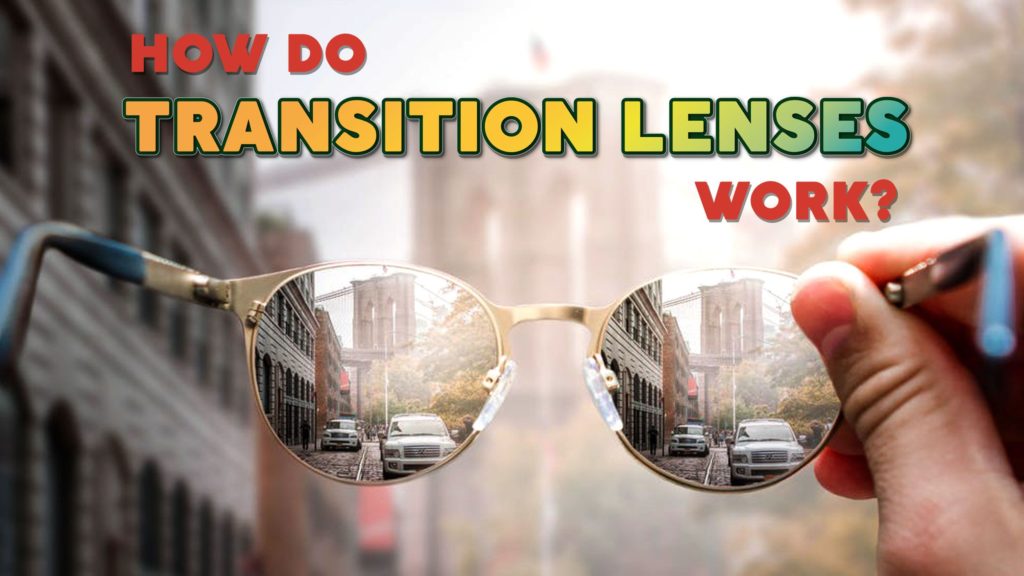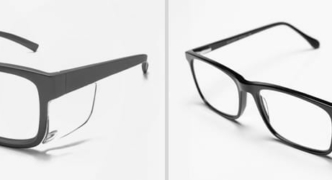
Prescription glasses wearers who want to avoid frequently switching between eyeglasses and sunglasses should consider frames with transition lenses. Photochromic or light adjusting lenses darken upon exposure to ultraviolet light and lighten to clear indoors for all-day wear.


What Are Photochromic Lenses?
Light adjusting or photochromic lenses contain molecules that react to exposure to UV light. Most lenses that transition are prescription, as people who do not require vision correction may only need to wear sunglasses. Most light adjusting lenses darken outside and gradually return to a clear color indoors for maximum visibility.
Photochromic lenses can be a good choice for wearers who frequently move between indoor and outdoor light levels. The need to take off glasses and put on sunglasses and then switch out sunglasses for glasses increases the risk of damage to or the loss of one or both pairs of eyewear. Glasses with light adjusting lenses are made to be multipurpose.
Types of Light Adjusting Lenses
Standard photochromic lenses darken when exposed to UV light outside and lighten indoors where less UV light is present. Most windows block enough UV light to keep glasses relatively clear and easy to see through while a wearer is indoors. For this reason, specialized Oakley transition lenses that are polarized and more sensitive can be helpful to wear while driving.
The original photochromic lenses developed in the 1960s by scientists at Corning Glass Works worked similarly to antique photographic film in the sense that silver-based crystals darkened lenses. Light adjusting lenses were popularized during the 1970s with Reactolite and Reactolite Rapide technology by the British Pilkington glass company. Today, Transitions® is the leading photochromic lens brand.
Transition Lens Colors
Light adjusting lenses are available in a wide variety of colors. Some optical brands make unique types of photochromic lenses. Check to see which transition lens technology is available for any brand of frames.
Evolve is the brand name of Ray Ban transition lenses, some of which transition between lighter and darker shades of a particular color or between colored and clear. Evolve lenses are available for non-prescription and prescription eyewear and can be polarized to eliminate glare and increase contrast and clarity.
Mirror Lens Options
Mirrored and polarized lenses may be an option for some light adjusting lenses. These lens coatings block horizontally reflected light to reduce glare. The surface of mirrored lenses will also reflect your surroundings. The choice between mirrored and polarized lenses is a matter of personal preference and style. Both of these lens treatments are effective at blocking glare.
Light adjusting lenses are not designed to block glare without additional mirror or polarized treatments. If you plan to wear light adjusting lenses in bright environments, upgraded lenses are worth the investment. It is also worthwhile to consider the effect that these treatments may have on glass when it is clear. For example, it may be necessary to adjust the angle of backlit screens for visibility when wearing glasses that have polarized photochromic lenses.
How Transition Lenses Are Made
There are two primary methods for making lenses that change color based on exposure to light: imbibing and Trans-Bonding™. The leading brand of photochromic lenses uses proprietary processes to make the latest generation of light adjusting lenses more responsive to shifts in lighting, darker outdoors and completely clear indoors in less time than older lenses.
The material of lenses plays a significant part in determining the most effective method of photochromic treatment. Some materials respond better to imbibing than others, while others can benefit from a surface treatment. The method used may have an effect on the longevity of the transitional effect, though technological advancements have led to both types of treatments lasting up to several years.
Imbibing
Imbibing is a thermal process that uses heat to draw photochromic dye into lenses. This process gets its name from the Latin word “imbibere,” which means “to drink in.” This process is the more conventional method for making light-adjusting lenses.
Some lens materials cannot imbibe photochromic dye. A surface treatment can make these materials shift color based on exposure to changing light levels. Developments in optical technology now allow for multiple methods of imparting photochromic properties to lenses.
Trans-Bonding™
The trademark Trans-Bonding™ process involves the application of photochromic molecules directly to the surface of lenses. This method achieves a uniform tint color regardless of the thickness of prescription lenses.
Lenses treated with this process tend to be more durable than other photochromic lenses, and this method can be combined with other treatments such as the application of anti-reflective or scratch-resistant coatings. If a lens material does not respond to imbibing, this process is a good alternative for crafting lenses that adjust to light levels.
How Light Affects Photochromic Lenses Behind the Windshield
Standard light adjusting lenses may not respond well to light levels inside vehicles. Most windows block a significant amount of UV light, and conventional photochromic lenses may not adjust to a level that allows for maximum visibility through a windshield.
The leading light adjusting lens brand has special technology for glasses worn while driving. These specialized lenses darken to levels sufficient for comfort and suitable for safety in vehicles during daylight hours. Polarization can also help to reduce glare that causes eye strain and fatigue during time spent behind the wheel.
Temperature & Photochromic Lenses
Temperature affects the performance of photochromic molecules. Warm temperatures tend to speed up the activity of the reaction that darkens and lightens lens tints. Cold temperatures result in slower transitions from dark to clear lenses. Advancements in light adjusting lenses have led to lenses that get darker outdoors and return to being fully clear indoors faster than previous generations.
In general, it takes about 15 minutes for photochromic lenses to block 80% of sunlight. Lenses may allow about 60% of light to pass through after five minutes spent indoors and take up to an hour to become completely clear. These periods of time may be shorter in higher temperatures or take longer when temperatures are low.
Photochromic Lenses vs Sunglasses
Most sunglasses have a consistent tint level. It is also possible to select eyewear with lenses that shift from darker to lighter shades of a selected tint, such as Ray Ban Evolve lenses. In general, photochromic lenses do not match the consistent levels of brightness reduction and sun protection that sunglasses provide.

FAQs
How can I get glasses with light adjusting lenses?
Select your favorite pair of prescription-ready frames and choose a lens type and finish. Light adjusting lenses are available for most brands and frame styles, along with clear and tinted lenses. Photochromic lenses are suitable for short periods of time outdoors, but may not protect eyes as much as sunglasses.
Do light adjusting lenses protect eyes from UV light?
Photochromic lenses may provide UV light protection, but this eyewear shifts in tint based on exposure to UV light. The speed with which glasses adjust also varies based on the temperature. Sunglasses provide a more constant level of lens tinting and can be fitted with polarized lenses to block glare.
What methods are used to make photochromic lenses?
The two methods used to make photochromic lenses are imbibing and Trans-Bonding™. Imbibing is a process in which heat draws photochromic dye into the lens where it stays below the lens surface. As some lens materials do not imbibe dye, the other method involves applying photochromic molecules to lens surfaces.
How do photochromic and polarized lenses compare?
Photochromic lenses change color when exposed to ultraviolet light. Polarized lenses have a lens coating that blocks most light that gets reflected horizontally from passing through. Polarized lenses come in a set shade and do not lighten or darken on the basis of changing light conditions like light adjusting lenses.
How long do light adjusting lenses last?
Light adjusting lenses continue to function at optimal levels for up to three years, a lifespan suitable for most prescription glasses. After several years, lenses may take longer to darken or lighten and the degree of tinting may not be the same as was initially achieved in varying light conditions. Prescription glasses with transition lenses are a great choice for glasses wearers who want to wear a single pair of frames indoors and outdoors. Non-prescription photochromic lenses may shift from lighter to darker tints of the same shade. Glasses with light adjusting lenses are suitable for short trips outside during daylight hours. Prescription sunglasses provide optimal protection during extended sun exposure.





























